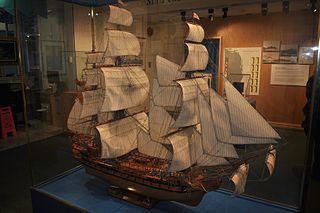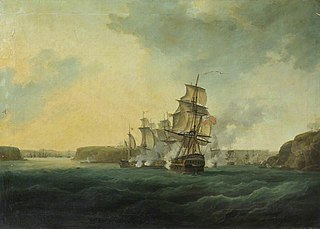
HMS Lion was a 64-gun third-rate ship of the line of the Royal Navy, of the Worcester class, launched on 3 September 1777 at Portsmouth Dockyard.

HMS Conqueror was a 74-gun third-rate ship of the line of the Royal Navy, launched on 23 November 1801 at Harwich. She was designed by Sir John Henslow as part of the middling class of 74s, and was the only ship built to her draught. Whereas the common class carried 28 18-pounder guns on their upper gun decks, the middling class carried 30, and only ten 9-pounder guns on their quarterdecks instead of the 12 of the common class.

HMS Orion was a 74-gun third rate ship of the line of the British Royal Navy, launched at Deptford on 1 June 1787 to the design of the Canada class, by William Bately. She took part in all the major actions of the French Revolutionary and Napoleonic Wars under a series of distinguished captains.

HMS Ajax was a 74-gun third rate ship of the line of the Royal Navy, built by Thomas Bucknall at Portsmouth Dockyard and launched on 23 December 1767. She was designed by William Bateley, and was the only ship built to her draught. She had a crew of 600 men.

HMS Royal Oak was a 74-gun third-rate ship of the line of the Royal Navy, built by Jonas Shish at Deptford and launched in 1674. She was one of only three Royal Navy ships to be equipped with the Rupertinoe naval gun. Life aboard her when cruising in the Mediterranean Sea in 1679 is described in the diary of Henry Teonge.

HMS Fame was a 74-gun third-rate ship of the line of the Royal Navy, in service during the Seven Years' War and the American Revolutionary War.
HMS Russell was a 74-gun third rate ship of the line of the Royal Navy, launched on 10 November 1764 at Deptford.

HMS Belliqueux was a 64-gun third rate ship of the line of the Royal Navy, launched on 5 June 1780 at Blackwall Yard, London. She was named after the French ship Belliqueux captured in 1758.

HMS Montague was a 74-gun third rate ship of the line of the Royal Navy, launched on 28 August 1779 at Chatham Dockyard.

HMS Venerable was a 74-gun third-rate ship of the line of the Royal Navy, launched on 19 April 1784 at Blackwall Yard.
HMS Alfred was a 74-gun third rate ship of the line of the Royal Navy, launched on 22 October 1778 at Chatham Dockyard.

HMS Cressy was a 74-gun third rate ship of the line of the Royal Navy, launched on 7 March 1810 at Frindsbury.

Bienfaisant was a 64-gun ship of the line of the French Navy, launched in 1754.

HMS Oxford was a 54-gun fourth-rate ship of the line of the Royal Navy, built by Francis Baylie in Bristol and launched in June 1674. Her guns comprised twenty-two 24-pounders on the lower deck, with twenty-two large sakers (8-pounders) on the upper deck and ten smaller sakers (5-pounders) on the quarterdeck.
HMS Reserve was one of six 40-gun fourth-rate frigates, built for the Commonwealth of England under the 1650 Programme, after the Restoration of the monarchy in 1660 she was incorporated into the navy of the Kingdom of England. She partook in no major Fleet actions during the First Anglo-Dutch War. After the Restoration during the Second Anglo-Dutch War she partook in the Battle of Lowestoft, the Four Days' Battle and the St James Day Battle. She spent the bulk of her service either in the Mediterranean or at Newfoundland. She foundered off Yarmouth in November 1703.
HMS Assistance was one of six 40-gun fourth-rate frigates, built for the Commonwealth of England under the 1650 Programme, after the Restoration of the monarchy in 1660 she was incorporated into the navy of the Kingdom of England. During her time in the Commonwealth Navy she partook in the First Anglo-Dutch War being present in the battles of Kentish Knock, Portland and The Gabbard. In the Mediterranean she was present at the Battle of Santa Cruz and the bombardment of Porto Farina, In the Second Anglo-Dutch War she was involved in the Battle of Lowestoft, Battle of Vagen and the St James Day Fight. She did not participate in fleet actions after this. She spent the rest of her service life undergoing several rebuilds and plying the waters as a cruiser protecting British trade and projecting British sovereignty. After nearly 95 years of Service she was sunk as a break water at Sheerness at the end of 1745.

HMS Lancaster was an 80-gun third rate ship of the line of the Royal Navy, launched at Bursledon on 3 April 1694.

HMS Dartmouth was a 50-gun fourth-rate ship of the line of the Royal Navy, one of eight such ships authorised by the Navy Board on 24 December 1695 to be newly built ; the others were the Hampshire, Winchester, Salisbury, Worcester, Jersey, Carlisle and Tilbury. The contract for the Dartmouth was signed in 1696 with shipbuilder James Parker, for the ship to be built in his site in Southampton, taking the name of the previous Dartmouth of 1693, and she was launched there on 3 March 1698.
HMS Newcastle was a 50-gun fourth rate ship of the line of the Royal Navy, built by Joseph Allin the elder at Sheerness Dockyard and launched on 10 March 1704.

HMS Princess Louisa was a 58-gun fourth rate ship of the line of the Royal Navy, built to the dimensions prescribed in the 1741 proposals of the 1719 Establishment at Limehouse, and launched on 1 July 1744.















